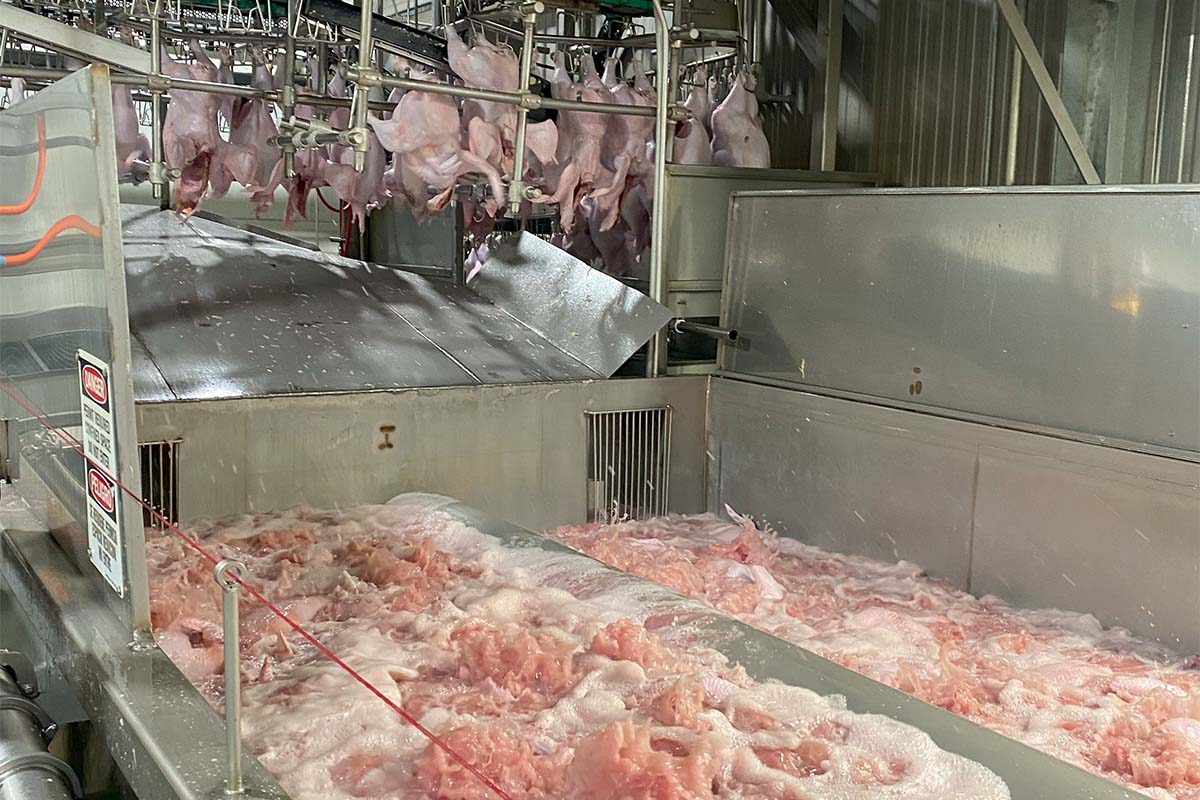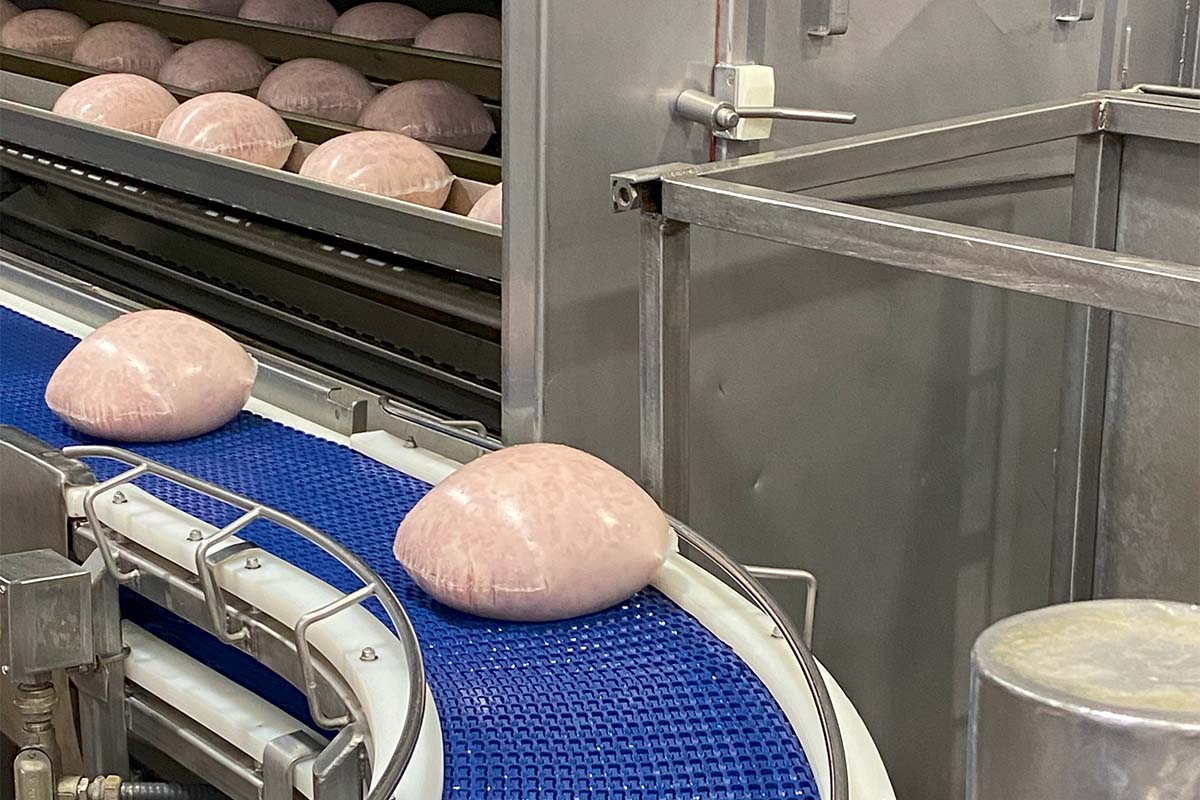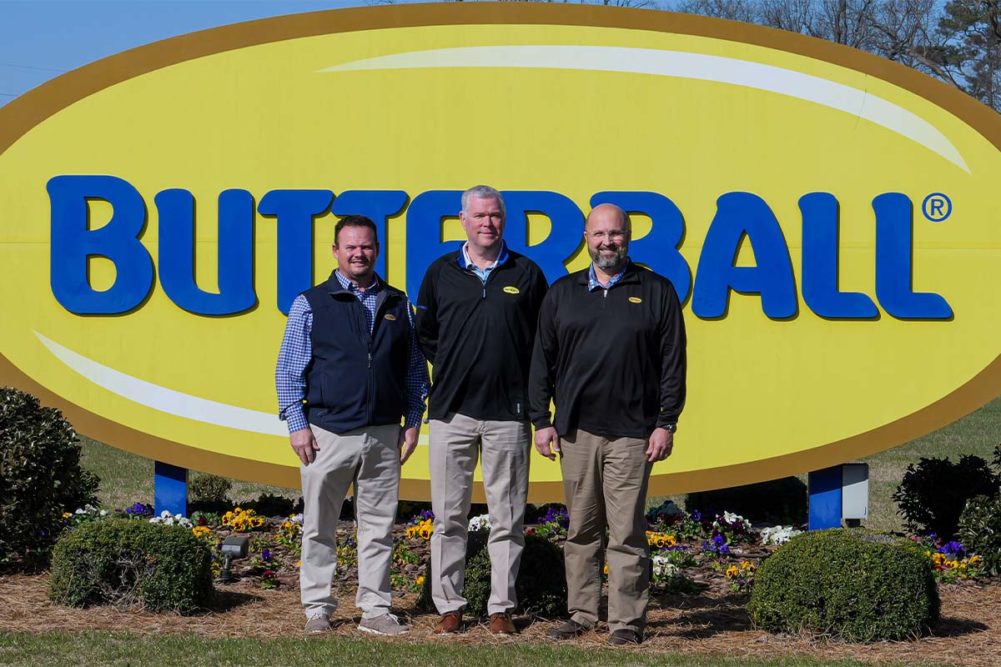The Butterball turkey plant in Mount Olive, NC, represents a continual evolution in processing. The original building was constructed in 1985 without ready-to-eat (RTE) or dry goods warehousing. Both were added in 1987. The plant added raw manufacturing in 1989 and additional freezer cold stores and shipping in 1991.The facility sits on approximately 15,100 acres of land and with the addition of a controlled atmosphere stunning (CAS) area with Humane-Aire equipment installed in 2014 that added 30,000 square feet, the facility covers roughly 900,000 square feet. In 2016, the company gutted its further processing operations, redesigned and retooled it, and added equipment to increase capacity by 12 million lbs to the further processing area.
About 285,000 “super toms” are slaughtered at the Mount Olive plant per week, averaging a live weight of 46 to 48 lbs each. Turkeys are hatched in North Carolina and males are grown locally. Females go to Butterball’s Arkansas facilities for grow out and slaughter and are processed for the table birds used for the holidays around Thanksgiving. The plant has the capacity to process 690 million lbs live per year with 150 million lbs RTE capacity and 6 million lbs of medallions for salads and meal kits. Retail tray packs and chubs of ground and sausage products make up 50 million lbs of capacity with high pressure processing (HPP) adding another 30 million lbs.
The Mount Olive plant sends about 60% of its product to retail with the remaining ebbing and flowing between commodity type products going to industrial customers and traditional foodservice.
Big birds
The super toms enter the facility in modules stacked on a truck and are unloaded by a crane one at a time onto a conveyor. The birds move through a Humane Aire controlled atmosphere stunning tunnel for six to eight minutes as the concentration of CO2 gradually increases.
To prevent worker fatigue, injury and turnover, the Mount Olive plant’s shackles on hanging lines sit low enough to the conveyor that birds do not require lifting. Workers place the feet in the shackles with birds still resting on the conveyor. The line then ascends and picks the birds off the conveyor for transport down the line. Before moving to defeathering and evisceration, the feathers from the birds’ left wings are removed and sent to be used as fletching for arrows.
Due to the size of the birds, some processes are still done manually, including evisceration.
“We know our bird size has always been a challenge for evisceration automation,” said Craig Leviner, complex manager at the Mount Olive facility. “But I have experience with it in chicken. It’ll happen here one day, and we just got to get a little bit more comfortable with it.”
Vice president of operations at Butterball LLC, Art Lankford, added, “There’s only a couple of companies in the world, one in America, that would even attempt to automate the evisceration of turkeys this size.”
Once eviscerated and ready, the super toms move to an approximately five-hour chilling process to bring temperatures from 104°F down to 40°F. The new Morris chilling system was installed to replace the previous system last year. Four hallways 180 feet long house the multi-function system, two agitating and two screw-type functions. The chilling water also contains a peracetic acid additive to control Salmonella. All controls connected to the chilling system throughout all four hallways can operate any area of the four hallways.
After chill, birds are rehung, in the same ergonomic fashion in which employees do not need to lift them off the conveyor, weighed by a Marel deck weigher and distributed to three different cut up lines according to size, small, medium and large.
A Marel cutter then cuts the birds in a top-bottom configuration. The bottom half gets precut by hand and machine cut into thighs, drums and back. Breasts and wings are precut and machine finished on the top half. A JBT deboner handles the drums from the wings and the flats go to grind. Breast meat is sized per customer specification and tenderloins are removed by hand. After cut up, backs and frames go to grind.
The Mount Olive plant operates four grind lines and produces fresh retail burgers, retail packs for the case in 3 lb and 1 lb sizes with a Bizerba machine checking for correct packaging, retail chubs in 3 lb and 1 lb sizes, as well as 10 lb chubs for foodservice and institutions. The retail fresh chubs also go through an in-house high pressure processing machine to add shelf life to the product.
A ready-to-cook area of the plant injects, tumbles, shapes and weighs all products to cook. Deli meats are shaped into both domes and hearts and cooked in film on racks with RTE products getting fried, sliced, smoked and finished in one of 11 Alkar steam ovens and are ready to eat. Cooked medallions are sliced and cut for salad and meal kits.
To streamline shipping, an elevator delivers made-up boxes down from a mezzanine to the line and a JLS Osprey robot packs case-ready packages into boxes. Once pallets are ready, a new robotic stretch wrapper puts the pallets together, eliminating the need for corner pieces of cardboard to provide stability.
Butterball’s operations succeed and continually improve due to its BOSS (Butterball Operating System Solutions) system. BOSS is a tiered structure starting at tier one, those on the floor, through upper management, such as Lankford. The system allows all levels to work through any problems, understand standards and hit goals with all levels working as a team to operate at maximum capacity.
“Our employees can have a voice in this startup meeting every day, and if it’s something they can’t work out, it’s escalated to the tier two and that supervisor level works on it,” Leviner said. “Then it goes to the superintendent and that chain goes all the way up to try to take these problems away. We’re trying to empower everybody all the way down with the tools to be successful and have a voice at that particular process.”
 The new Morris auger chiller replaced a drag chiller last year. (Source: Bob Sims/Sosland Publishing Co.)
The new Morris auger chiller replaced a drag chiller last year. (Source: Bob Sims/Sosland Publishing Co.)Safety star
Outside the Mount Olive plant, a flag with the state of North Carolina with a star, flies along with the American flag. The flag represents not only a commitment to safety, but the achievement of ensuring the safety of everyone at the facility.
OSHA (the Occupational Safety and Health Administration) recognizes star sites at federal and state levels, and Butterball’s turkey plant qualifies at the state level giving it the honor to fly the flag as a North Carolina Star VPP (voluntary protection program) recipient.
“Now when you think about it, there’s 35-40 million businesses in the United States and less than .01% can actually qualify to fly that star flag, and we qualified for that last year,” said Brian Hughes, complex safety and security manager at the Mount Olive facility. “Our incident rate was 85% lower than industry average. So we were quite successful last year.”
Recertification for the Carolina Star VPP program happens every three to five years.
“We celebrated that recertification with North Carolina Labor Commissioner, Josh Dobson, here on site. There were also a lot of dignitaries and state officials that were part of the presentation and part of that whole process,” Hughes said.
Neal Walsh, chief operating officer at Butterball LLC, added, “The star site here is a very prestigious honor industry wide.”
The safety culture at Butterball starts at the top and works down, and it’s not exclusive to any one company. When it comes to worker safety, companies not only talk to one another, but share best practices and continually work to make the industry, as a whole, safer.
“We talk with our competition,” Walsh said. “We want to make sure that we’re as tight as anybody can be and they agree with that. And then the folks at operations all report to Art [Lankford] and that communication works better than anything I’ve ever seen because in our Butterball way, the first thing is safety.”
Every staff meeting Lankford has begins with a discussion about safety and every BOSS meeting starts with safety. Every onboarded employee goes through a broad training as well as training specific to the job they were hired to do through the company’s training department. The training department reports to the operations team, and new hires must pass their training before they can work on the floor.
“The length of time they’re in the program is based on the severity of the job,” Leviner said. “So if you’re in a debone job or a first processing job where you may be using a tool, you may have to onboard longer than somebody doing a packing job and that would apply all the way through using our PIT (power industrial trucks) equipment such as forklifts, pallet jacks and those type things.”
To further spread the learning, Lankford requires complex managers to send him a root cause analysis (RCA) with a fishbone and 5 whys diagram (a visual tool used to dig deeper into root causes of an accident) within 48 hours of every recordable incident. Lankford then personally reviews the RCAs with the complex manager and safety manager. Recordables and RCAs are internally published for every complex manager to view.
“The goal is to eliminate the possibility of injuries through training, changing of setups and equipment, but the other goal is to learn from any accidents,” Lankford said.
 Butterball cooked and ready-to-eat deli meats are formed in hearts and domes at the Mount Olive, NC, facility. (Source: Bob Sims/Sosland Publishing Co.)
Butterball cooked and ready-to-eat deli meats are formed in hearts and domes at the Mount Olive, NC, facility. (Source: Bob Sims/Sosland Publishing Co.)Automating and adjusting
For more than two decades, Butterball’s Mount Olive plant has continuously upgraded its facility through additions, automation and new technology. While some of those investments did increase capacity and speed, the strategy hasn’t been and isn’t necessarily about just increasing production numbers.
Like the company’s BOSS meetings, the direction of automation comes from the bottom and flows upward. Those on the floor doing the jobs tell management which jobs are difficult and strenuous. Turnover numbers inform upper management which jobs are difficult. The associates on the line point out the inefficiencies.
Walsh gave an example regarding two-joint wing cuts and a healthy export market. Before, Mount Olive would send the pieces to an outside warehouse in bulk to be packed. Two women working on the line told management that they could box them similar to bulk ground turkey with the right equipment and set up. Leviner, Lankford and their team figured out how to get them what they needed.
“Those young ladies took care of it, saved us about $10,000 a week in the cost of having somebody else do it versus doing it right in flow,” Walsh said. “So, a lot of the automation ideas come from that.”
Since 2014, the total live pounds processed has declined, but the amount of further processed product has increased. This has been a strategic move based on the commercial team’s (sales) information regarding consumer and customer demand.
“What we continue to do every day is to invest in the facilities to create that next level up of product,” Walsh said.
Ultimately Butterball and the Mount Olive plant work to serve people, community and customers through the food they produce and the way they produce it.
“It’s all about your people,” Walsh added. “Our purpose is we exist to help people pass love on, and that could be at the dinner table, but it can also be out there on that floor because we take folks, they come in here, they work hard and they want to succeed.”



